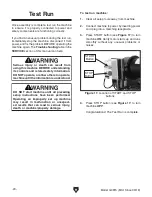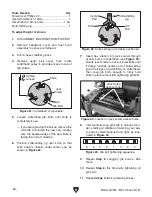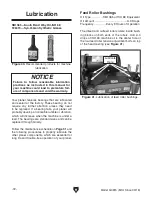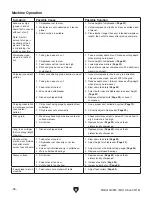
Model G0815 (Mfd. Since 09/18)
-23-
Planing Tips
Below is a list of wood characteristics you may
encounter when planing. The following descrip-
tions of defects will give you some possible
answers to problems you may encounter while
planing different materials. Possible solutions fol-
low the descriptions.
Chipped Grain
Problem: Usually a result of cutting against the
grain, planing lumber with knots or excessive
amount of cross grain, or using dull knives.
Note: Some amount of chipping is normal with
highly figured wood.
Solution: Decrease the depth of cut. Reduce the
feed rate. Inspect your lumber and determine if its
grain pattern is causing the problem. If the lumber
does not show substantial crossgrain, inspect
your knives.
Fuzzy Grain
Problem: Usually caused by surfacing lumber
with too high of a moisture content. Sometimes
fuzzy grain is an unavoidable characteristic of
some woods, such as basswood. Fuzzy grain can
also be caused by dull knives.
Solution: Check the lumber with a moisture
meter. If moisture is greater than 20%, sticker the
lumber and allow it to dry. Otherwise, inspect the
knife condition.
Snipe
Problem: Occurs when board ends have more
material removed than the rest of the board.
Usually caused when the workpiece is not prop-
erly supported as it goes through the machine. In
many cases, however, a small amount of snipe is
inevitable.
Solution: Hold workpiece up slightly as it leaves
the outfeed end of the planer. The best way to
deal with snipe is by planing lumber longer than
your intended work length and then cutting off the
excess after planing is completed.
Cutting Problems
•
Inspect your lumber for twisting or cupping,
and surface one face on a jointer if necessary
before planing workpiece.
•
Scrape off all glue when planing glued-up
panels. Dried glue can quickly dull knives.
•
DO NOT plane more than one piece at a
time.
•
Never remove more than the recommended
amount of material on each pass. Only
remove a small amount of material on each
pass when planing wide or dense stock.
•
Support the workpiece on both ends. Get
assistance from another person if you are
planing long lumber, or use roller stands to
support the workpiece.
•
Measure the workpiece thickness with cali-
pers to get exact results.
•
Carefully inspect all stock to make sure it is
free of large knots or foreign objects that may
damage your knives, cause kickback, or be
ejected from the planer.
•
When possible, plane equal amounts on
each side of the board to reduce the chance
of twisting or cupping.
•
Use the entire width of the planer to wear
knives evenly. With narrow workpieces, alter-
nate between far left, far right, and the middle
of the table. Your knives will remain sharp
much longer.
•
To avoid "chip marks," always plane WITH
the grain direction of the wood. Never plain
cross-grain or end-grain.
•
Plane ONLY natural wood fiber. Do not
plane wood composites or other materials
that could break up in the planer and cause
operator injury or damage to planer.
•
Always true cupped or warped stock on a
jointer before planing.
Summary of Contents for G0815
Page 56: ......
















































